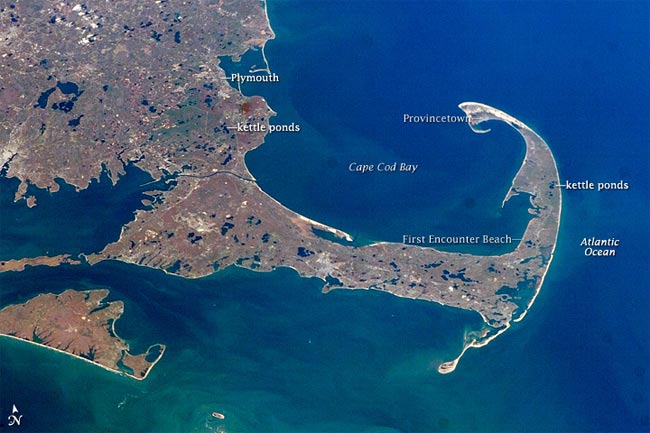The First Thanksgiving: A View From Space

Cape Cod – the boot-shaped peninsula of Massachusetts, where the Pilgrims first set foot – is still a haven for hundreds of thousands of visitors each summer. Its history and geology were, in a sense, captured by Expedition 16 astronauts aboard the International Space Station in 2007.
The digital photograph shows the spot where the Pilgrims (also called English Separatists) first encountered native Indians, which they named First Encounter Beach.
In September 1620, the Pilgrims left Europe to set up a colony near the mouth of the Hudson River. On Nov. 20, they spotted land and confirmed it to be Cape Cod.
The Pilgrims initially decided to sail farther south, but quickly became wary of the shallow waters and shoals east and south of Cape Cod and Nantucket. They sailed around the northeastern tip of the Cape and on Nov. 21, 1620, dropped anchor just off the shores of modern-day Provincetown. While resting in that harbor, they composed and signed the Mayflower Compact, an agreement to establish self-government.
(On the original Mayflower Compact, the date is listed as Nov. 11. When Western societies switched from the Julian calendar to the Gregorian calendar, 10 days were added, turning Nov. 11 into Nov. 21.)
In the following weeks, the Pilgrims had their first encounter with the Wampanoag Indians, native people whose ancestors may have explored and inhabited Cape Cod as early as 11,000 years ago. Eventually, the Pilgrims made their way to the western shores of Cape Cod Bay, landing near an abandoned Wampanoag settlement known as Patuxet.
The first Thanksgiving, which is thought to have occurred in 1621, was a moment for the Pilgrims to thank God for allowing them to kill enough game and grow sufficient crops to get through the winter, according to Anne Blue Wills, assistant professor of religion at Davidson College in North Carolina. Rather than feasting, those Pilgrims would have spent much of their day in church contemplating the mercies of God's covenantal love, Wills said.
Sign up for the Live Science daily newsletter now
Get the world’s most fascinating discoveries delivered straight to your inbox.
The Cape's sandy peninsula and a fair bit of southeastern Massachusetts are, in a way, also migrants. The area was both built up and scoured by the Laurentide Ice Sheet, which stretched down past Martha's Vineyard and Nantucket during Earth's last major Ice Age. In their advance and retreat, the glaciers making up the ice sheet scraped rock from Earth's surface, eventually depositing it on Cape Cod. The U.S. Geological Survey estimates the deposits are 200 to 600 feet thick across the region.
Though the astronauts' photo doesn't show all the rocks left behind, it does show the dozens of kettle-hole ponds. As the ice sheet retreated, sediments washing out of the glaciers occasionally covered chunks of ice. Those ice blocks would eventually melt and collapse the sediments, creating the space for the fresh groundwater-fed ponds we see today.
Another glacial treat: Though not mentioned in the Mayflower, Plymouth Rock is a glacial erratic, or a large boulder that dropped out of a glacier.










